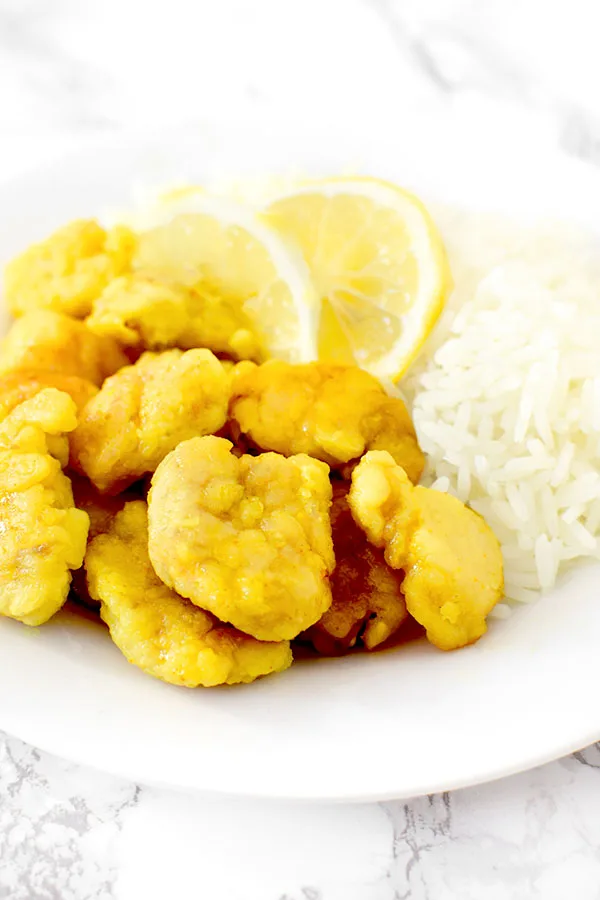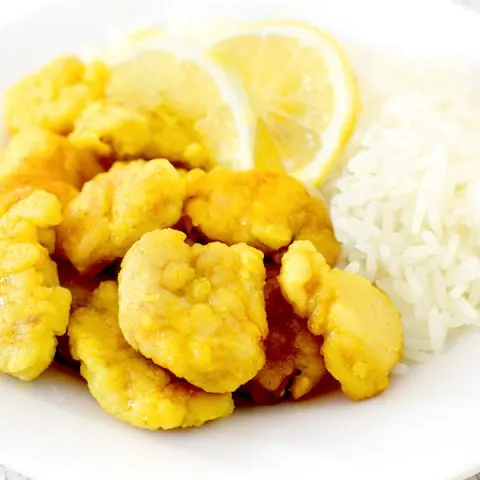Chinese lemon chicken is fried chicken pieces coated in a mildly sweet lemony sauce. Serve with rice and steamed vegetables.

I’ve become somewhat obsessed with making lemon dishes since my family first moved to Israel where lemon trees speckle neighborhoods they live in.
I often pick lemons off the public trees, so I'm always looking for ways to use them. When I saw Chinese lemon chicken was a thing, I couldn’t wait to try it.
Chinese lemon chicken isn’t an authentic Chinese dish, rather it is a Chinese-takeout classic native to Canada.
I originally thought it would be a lemon version of orange chicken, but I was wrong. The two dishes are pretty different, as orange chicken calls for soy sauce and rice vinegar.
Lemon chicken is also simpler to make because it calls for less ingredients.
I really enjoy the balance of lemon and the sweetness of the sugar. Often I find lemon dishes too sour for my taste, but not this dish.
I prefer using one lemon when making the sauce, but if you like your lemon chicken more on the sour side, use two.
As you may expect, lemon chicken, like most lemon flavored foods, is yellow.
Desserts like lemon bars and lemon meringue pie get their bright yellow color from the eggs. Other recipes, like lemon crinkle cookies and this lemon chicken, call for food coloring.
Instead of artificial food coloring, I use turmeric to naturally color my foods.
I got the idea because it does just that in Israeli yellow rice. You don’t need to worry about it changing the taste, though.
Turmeric doesn’t add any flavor unless you put a lot in, in which case I find it gives a soapy taste.
So, as long as you follow the recipe, you will have naturally beautifully yellow lemon chicken that tastes just right.
HOW TO DREDGE CHICKEN
Double Handed
Use one hand to dip the chicken in the egg and the other to roll it in flour. By using both hands, you avoid getting thick layers of batter on your fingers known as “club hand.”
Container Technique
Place half the flour at the bottom of a container. Add the chicken and cover with the remaining flour. Cover with a lid and shake for a few minutes. Each piece should come out well coated.
With methods, shake off any excess flour and fry.
DO NOT DOUBLE COAT
When making fried chicken or fried chicken wings, double coat them, giving them a thick exterior which keeps them juicy.
When first making this recipe, I did half a batch with a double coat and half a batch with one coat. I found the breading was too thick for such small pieces which overpowered the chicken flavor.
Dark meat vs White meat
Most people have a preference between eating white meat or dark meat. They both certainly have their benefits and detriments in this recipe.
White meat has the benefit of being lean, more readily available as boneless and skinless, and it cooks quickly. Dark meat is juicier and does not dry out as quickly, making it a safer choice.
At the end of the day, you can use either white or dark meat for this recipe. The choice is yours. I often just choose based on what I have on hand.
GLUTEN FREE OPTION
For a gluten free alternative, use corn starch or potato starch instead of flour. They both fry very nicely.
A WORD ON OIL
When frying chicken, the temperature of the oil is important. If it’s too cold, the chicken will be oily. On the other hand, if the oil is too hot, the crust will fall off. With a thermometer, it should about 350°F or 175°C to 375°F or 190°C degrees.
If you don’t have a thermometer, when the oil seems hot, drop a little flour into the oil. If the flour sizzles and floats on the top, it’s hot enough. To make sure it’s not too hot, keep it around medium-low and adjust as needed.
IS KOSHER CHICKEN BETTER?
Kosher animals are kept in better conditions than non-kosher animals due to strict kosher health requirements of the animals.
Also, the salting process used as part of the process of making meat kosher is similar to dry brining, and therefore produces a better quality meat.
While I’ve only eaten kosher meat so I cannot compare, I’ve been told by non-Jews who do not keep kosher that they’ve noticed that kosher chicken is of superior quality to cook with.
SHOULD YOU WASH CHICKEN?
According to the USDA, you should not wash meat or poultry, since water can splash bacteria up to 3 feet surrounding your sink.
A study done by Drexel University shows that it is best to move meat and poultry directly from package to pan. The heat from cooking will get rid of any bacteria that may be present.
HOW CAN I CLEAN MY CHICKEN WITHOUT WASHING IT?
If you want to clean your chicken without washing it, wipe it down with a wet paper towel.
Just make sure the paper towel doesn't touch anything else and to toss the paper towel right away.
HOW TO DEFROST CHICKEN
IN THE FRIDGE
Defrosting chicken in the fridge is the most highly recommended.
To do this, place the frozen chicken in a pan and let it thaw. Oftentimes, when chicken thaws, it releases liquids that can leak onto your fridge, so the pan is really helpful.
Chicken typically takes a full day to thaw. Once thawed, it can remain in the refrigerator for a day or two before cooking.
IN COLD WATER
Defrosting chicken in water should take two to three hours.
Submerge your sealed chicken in a pot or bowl full of cold water. Change out the water every 30 minutes or so.
Do not hot use water because it can start cooking your chicken.
Can you cook FROZEN chicken?
According to the USDA, you can cook frozen chicken. It will take 50% longer to cook, but it’s an option.
You should also cook it on a roasting rack or over vegetables so that the heat can circulate around the chicken.
CAN YOU REFREEZE RAW CHICKEN?
According to the USDA, “food thawed in the refrigerator is safe to refreeze without cooking.” However, you do lose quality when refreezing previously defrosted meat.
Every time you defrost meat, it loses moisture as it thaws, which also leads to a loss in flavor. To compensate for this, marinate the chicken to add more flavor and juice.
The USDA also says not to “refreeze any foods left outside the refrigerator longer than 2 hours; 1 hour in temperatures above 90°F.”
SHOULD YOU BRINE?
Brining actually doesn’t do anything to help poultry. In fact, it makes it soggy rather than juicy, with watered-down flavor.
Aromatic brines and stock don’t help with flavor either. This is because the salt pulls water molecules in, leaving most of the flavor behind.
DRY BRINING
A dry brine, on the other hand, loosens up muscle fibers, allowing them to retain more moisture without adding any excess liquid.
Initially, the salt draws moisture out, then it dissolves in this liquid, creating a concentrated brine, which eventually gets reabsorbed. This leads to more intensely flavored results.
An added benefit is that it also requires less space and mess than a water brine. Not to mention the fact that it allows for crispier skin.
CAN YOU DRY BRINE KOSHER chicken?
Food experts are often under the impression that kosher meat and poultry cannot be brined and dry brined.
This is because of the koshering process, which involves salting the meat. However, the process is not nearly as long as the dry brining process, and unlike a dry brine, the poultry is soaked to remove the salt.
So, since the process is different than a dry brine, it is fine and even recommended to dry brine kosher poultry and meat.
How do you dry brine chicken?
Begin by patting the chicken with paper towels. This will help the salt adhere to the chicken.
Grab pinches of kosher salt and sprinkle it over the chicken until the chicken is generously salted and evenly coated.
Place the dry-brined chicken on a rack or a plate and refrigerate it. Refrigerate chicken pieces for at least 1 hour, skinless pieces for 30 minutes to 1 hour or up to about 12 hours, and a whole chicken for 8-24 hours.
Once the waiting period is up, there is no need to rinse off the chicken. Just cook it as usual.
HOW TO STORE CHICKEN
Place cooled chicken in an airtight container or wrap in heavy-duty aluminum foil or plastic wrap. Store in the fridge for up to 4 days.
HOW TO FREEZE CHICKEN
Freeze leftovers within 3-4 days. Place cooled chicken in an airtight container or resealable freezer bag.
Freeze for up to 4-6 months. After that, it is still safe to eat, but the quality begins to degrade.
Kosher Chinese Lemon Chicken

This lemon chicken is a Canadian Chinese-Takeout classic.
Ingredients
Chicken
- 2 boneless skinless chicken breasts or 4 boneless skinless chicken thighs, cubed
- 1 egg, beaten
- Zest from one lemon
- ½ cup cornstarch* (60 grams)
- ¼ cup all-purpose flour (30 grams)
- ½ tablespoon salt
- Oil, for frying
Sauce
- ½ cup water (120 millilitres)
- ¼ cup white sugar (50 grams)
- juice from 1 lemon
- 2 tablespoon cornstarch
- ½ teaspoon turmeric
Instructions
- Add chicken, lemon zest, and egg to a mixing bowl. Set aside.
- In a separate mixing bowl, whisk together cornstarch, flour, and salt. Dredge each piece into the flour.
- In a large frying pan or a wok, heat oil. When it seems hot, add a little flour to the oil. If it fries, it is hot enough.
- Fry the chicken for 3 to 4 minutes or until golden brown. Transfer to a cooling rack and repeat with remaining chicken.
- In a saucepan, combine the sugar, water, lemon juice, cornstarch, and turmeric. Bring to a boil. Turn off the heat and add cooked chicken. Stir until well coated.
Notes
Note: you can use ⅔ cup of flour instead of using any cornstarch if you prefer.
Nutrition Information:
Yield:
4Serving Size:
1Amount Per Serving: Calories: 481Total Fat: 16gSaturated Fat: 4gTrans Fat: 0gUnsaturated Fat: 11gCholesterol: 234mgSodium: 1057mgCarbohydrates: 36gFiber: 1gSugar: 13gProtein: 48g
NIck
Friday 22nd of May 2020
HIi - in the instructions you mentioned lemon zest for the chicken, but it's not in the ingredients for the chicken, Should there be lemon zest and/or juice in the chicken? Thanks!
ElissaBeth
Friday 22nd of May 2020
The lemon from the sauce says to be zested and juiced. The zest goes in with the chicken and the juice goes in with the sauce. I just adjusted the ingredient list to make that more clear :)
Alrack
Sunday 5th of May 2019
for Diabetics is it possible to substitute potato starch for the cornstarch & almond flour for the flour? TIS
ElissaBeth
Monday 6th of May 2019
I've never tired it. I think it should work. I've had success changing out regular flour for potato flour in some recipes, so that may work to. I don't think it will ruin the dish if you do it. If you've ever made fried chicken with almond flour and liken the results then I think it would work here. Please let me know how it comes out!